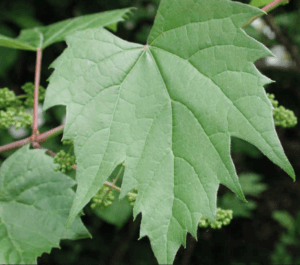Common Name: Fox Grape
Specific Name: Vitis labrusca
Known Occurrence at Taylor Point:Map Areas: Beach 1E, Cliffs 2C, Cliffs 2D, Cliffs 2F, Woodlands 3A, Woodlands 3B, Woodland 3C, Woodland 3D, Bridge 4A

Category: Native, Vine
Ecological Considerations:
Vitis labrusca is a climbing, branching woody vine that generally grows 10 – 40 feet long. The trunk bark is brown and shredded. Its leaves grow about 4 – 8 inches wide are widely spaced along the shoots and stems. The upper surface of the leaf is smooth and green while the underside is covered in brown and/or white wooly hairs.
This woody vine prefers full sun to partially sunny exposure and wet to moderately wet conditions. It grows well on rocky and sandy soils. It is frequently found in disturbed areas, alongside forests, along roadsides, and in clearings.
Fox Grape usually blooms in late spring or early summer. The fragrant blossoms last only about a week and offer a sweet musty fragrance. Following the blossoms, the plant puts oft its characteristic bluish beach berries, which mature during the late summer or the fall, grow to ½-¾ of an inch across bearing a juicy flesh and 2-6 seeds. The ripe berries may be sweet or they may be tart and often have musky overtones. Fox Grape vine spreads by reseeding itself.
Map Areas where this plant can be used for Revegetation:
Propagation Mechanisms/Strategies for Encouraging its Establishment:
Some sources recommend sowing seed in a cold frame as soon as the seeds are ripe. Six weeks of cold stratification may improve germination rates. Germination may take place in the first spring, or may require another year. Seedlings can be placed in individual pots when they are large enough to handle and these can be grown in a cold frame for their first winter and planted in early summer.
These vines can also be propagated via wood cuttings. See http://mikesbackyardnursery.com/2014/01/how-to-propagate-grapes-from-hardwood-cuttings/ for more information on propagation from cuttings.
Best Planting Practices/Options and Pros and Cons of Options:
Key Issues Regarding its Ecology ( e.g. Which Invasives Threaten it, What Conditions Favor it)
Associated Ecological Benefits: Availability of Locally Sourced Seeds and Plants:
Fox Grape is ecologically significant in that its fragrant flowers are cross-pollinated by bumblebees, honeybees, and other bees, that collect pollen from the flowers a they feed on its nectar. Other insects are known to feed on Fox Grape foliage, bore through its woody stems, and suck juices from its vines. Birds and mammals also eat the vine’s fruits, helping to spread the plant’s seeds to new areas. Among the birds known to feed on the grapes are Ruffed Grouse, Bobwhite, Northern Flicker, American Crow, and Cardinals. Coyotes, Red Fox, Gray Fox, Raccoons, Opossums, Skunks, and Squirrels also eat the grapes and White-Tailed Deer browse on the foliage. Because the vines provide dense leafy cover, wildlife and birds take cover and nest within and under them. In addition many insects are attracted to the wild grapes and in turn provide a food source for birds.
Availability of Locally Sourced Seeds and Plants:
Case Studies of Native Plant Establishment Efforts/Lessons Learned:
Additional photos:

Sources cited:
Go Botany
Illinois Wildflowers
Plants for a Future
Mikes Backyard Nursery
Key Words:
Native Woody Vines
Fox Grape
Vitis labrusca
